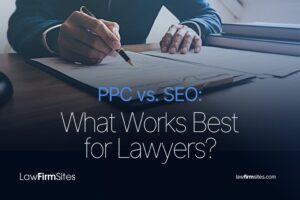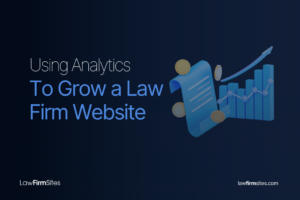PPC vs. SEO: What Works Best for Lawyers?

For most law firms, growth depends on being visible at the exact moment a potential client searches for help. Pay‑per‑click (PPC) advertising and search engine optimization (SEO) are two primary paths that can take you to your marketing goals. Each has strengths, limits, and different timelines, and the best results often come from using them together. This guide explains how PPC and SEO work for lawyers, when each makes sense, and how a hybrid plan can produce steady leads and lower cost per case over time.
What is PPC? (Pay‑Per‑Click marketing)
PPC places your law firm’s ads above or alongside organic results and charges you when someone clicks. In Google Ads, your ad placement is determined by Ad Rank, which factors in your bid, ad relevance, expected click‑through rate, landing page experience, and other signals such as device and location. When your ad and landing page closely match the searcher’s intent (for example, “car accident lawyer near me”), you can earn a higher position at a lower effective cost because relevance improves your Quality Score and expected impact of assets.
PPC offers three major advantages for attorneys and their law firms.
First, it is fast: you can launch ads for specific practice areas and zip codes and appear within hours.
Second, it is tightly targeted: you can filter by location, time of day, device, and even exclude keywords that do not match your intake criteria.
Third, it is measurable: you can track calls, form fills, chat starts, and booked consultations back to the keyword and ad that drove them.
There are trade‑offs. Legal keywords are among the priciest in paid search; industry benchmarks show Attorneys & Legal Services with some of the highest average costs per click on Google Ads. High CPCs (cost-per-clicks) magnify any inefficiency in targeting or intake, so success depends on rigorous negative keywords, relevant ad copy, fast pages, and disciplined bidding.
What is SEO? (Search Engine Optimization marketing)
SEO earns organic visibility by improving your site’s technical health, content quality, and authority so that search engines can surface your pages for relevant queries. Google’s public guidance emphasizes helpful, people‑first content and systems designed to elevate reliable results. For law firms, that means practice‑area pages that clearly answer legal questions, up‑to‑date attorney bios, well‑structured service content, and a local profile that matches your real‑world details.
SEO’s benefits compound. Strong organic rankings produce ongoing traffic without paying for each click, and click‑through rates for top organic positions remain substantial in many industries. Local SEO matters as well, such as providing Google Business Profiles, consistent name‑address‑phone data, reviews, and localized content, which help you appear in the map pack for city and neighborhood terms.
However, it is important to note that time is the ultimate takeaway in marketing. A study showed that meaningful ranking gains often take months, and top‑ranking pages skew older on average. Because legal queries are competitive, sustainable results come from steady publication, clean site architecture, authoritative citations, and relevant links earned over time.
The role of your budget in PPC and SEO marketing
Budget shapes strategy in legal marketing, and with PPC, spending affects impression share and volume, but efficiency hinges on quality. Two firms can bid on the same keyword and pay different prices depending on ad relevance, expected CTR (click-through-rate), and landing page experience, signals that roll up into Ad Rank. If your ads match search intent and your pages satisfy the query quickly, you may achieve more clicks at a lower effective cost than a higher bidder with weaker relevance.
With SEO, budget is about resourcing consistent work, which involves technical fixes, content production, digital PR, and local profile management. You cannot buy a position, but you can invest in activities that raise trust and usefulness over time. Importantly, SEO funds do not disappear when the campaign pauses, as content, internal links, and improved site performance continue to drive value long after publication, though upkeep is still required as search systems evolve.
A practical rule for many firms is to try and allocate immediate‑need budgets to PPC for time‑sensitive dockets (e.g., “DUI lawyer tonight”) while investing a fixed monthly amount in SEO to build durable visibility for core practice areas. Track cost per qualified lead from both channels and adjust according to your monthly needs.
How do hybrid strategies work? Are they the better option?
In competitive legal markets, PPC and SEO reinforce each other. A hybrid approach uses PPC for rapid demand capture while SEO builds long‑term discovery and trust. Here is a simple framework that many firms apply:
- a) Use PPC to validate keywords and messaging, then feed winners into SEO
Launch tightly themed ad groups around specific intents, “truck accident lawyer,” “probate attorney,” “premises liability attorney”, and evaluate which queries drive qualified consultations at an acceptable cost. High‑performing queries signal which practice pages and FAQs to strengthen. This reduces guesswork in your content plan.
- b) Use SEO to lower blended acquisition costs
As cornerstone pages and local profiles start ranking, you can shift budget from expensive head terms to long‑tail or remarketing in PPC. Because you no longer need to pay for every click on core terms, your blended cost per lead trends down.
- c) Share landing pages and insights across channels
The best PPC landing pages often become strong organic pages when you expand them with authoritative answers, attorney credentials, schema markup, and internal links. Conversely, organic pages with high engagement can be cloned and streamlined into PPC‑specific variants that load quickly and match ad copy.
- d) Double‑up on high‑value real estate when it matters
For ultra‑competitive categories, such as catastrophic injury, medical malpractice, and criminal defense, occupying both an ad slot and an organic slot can increase total clicks and reduce the chance that a rival captures the searcher. Different page elements split attention; appearing twice boosts your odds of the click.
- e) Sync local signals
Align your Google Business Profile categories, page titles, and ad keywords and maintain consistency across PPC and on‑site content. Reduce ambiguity for search engines and users to improve both paid quality signals and organic relevance.
- f) Measure beyond the click
Track calls, form submissions, chat, and signed retainers by channel and keyword. Use call recording and tagging without compromising client privacy to identify which queries produce qualified matters. Feed those insights back into negative keyword lists, content briefs, and internal link structures.
Combine strategies for maximum marketing output
PPC gives lawyers immediate reach and precise targeting, while SEO builds compounding visibility and trust through helpful content and strong local signals. Budget should match goals: use PPC to capture time‑sensitive demand and validate messaging, and invest steadily in SEO to reduce reliance on paid clicks over time. For most firms, a hybrid plan that blends rapid demand capture with long‑term organic growth provides the best balance of volume, cost control, and resilience.
If you want deeper checklists, examples, and next steps for a blended strategy, explore the resources at Law Firm Sites for practical guidance you can put to work.
Did you like this post? Here are some others you might enjoy:

For most law firms, growth depends on being visible at the exact moment a potential client searches for help. Pay‑per‑click…

Strong legal marketing rewards depth. When potential clients face high-stakes decisions, they search for thorough, trustworthy guidance that clearly explains…

Data is the most reliable guide for growing a law firm website because it shows what clients actually search, where…

